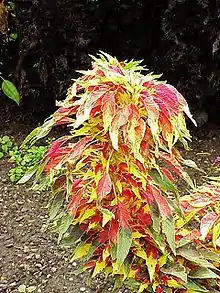| Amaranthus tricolor | |
|---|---|
 | |
| Scientific classification | |
| Kingdom: | Plantae |
| Clade: | Tracheophytes |
| Clade: | Angiosperms |
| Clade: | Eudicots |
| Order: | Caryophyllales |
| Family: | Amaranthaceae |
| Genus: | Amaranthus |
| Species: | A. tricolor |
| Binomial name | |
| Amaranthus tricolor | |
| Synonyms[1] | |
|
List
| |
Amaranthus tricolor, known as edible amaranth,[3] is a species of flowering plant in the genus Amaranthus, part of the family Amaranthaceae.
The plant is often cultivated for ornamental and culinary purposes. It is known as bireum in Korea;[3] tampala, tandaljo, or tandalja bhaji in India;[4] callaloo in the Caribbean; and Joseph's coat in other areas, in reference to the Biblical story of Joseph and the coat of many colors. Although it is native to South and South-East Asia, A. tricolor is one of several species of amaranth cultivated in warm regions across the world. Cultivars have striking yellow, red, and green foliage.
Culinary uses
_Kuntze%252C_1804.jpg.webp)
The leaves and stems may be eaten as a salad vegetable. In Africa, it is usually cooked as a leafy vegetable.[5] It is usually stir fried or steamed as a side dish in both China and Japan.
China
In China, it is referred to as xiàncài (simplified Chinese: 苋菜; traditional Chinese: 莧菜) and is often stir-fried with garlic and salt.
Korea
In Korea, the plant is referred to as bireum (비름). Small-leaved, reddish-stalked chambireum (참비름, "true bireum") is used as a namul vegetable in Korean cuisine. Considered a san-namul (wild green) that grows abundantly in the countryside, it tends to be foraged rather than planted and harvested.[6] It has an earthy and nutty flavor, and goes well with both gochujang- and soup soy sauce-based seasonings, and bori-bap (barley rice).[6][7]
 Bireum-namul (seasoned edible amaranth)
Bireum-namul (seasoned edible amaranth)_Flower.jpg.webp) Amaranth(Edibles) Flower
Amaranth(Edibles) Flower
In culture
It appears on the coat of arms of Gonville and Caius College, Cambridge, where it is called "flowers gentle".
Amaranthus gangeticus
Amaranthus gangeticus is considered a synonym of A. tricolor,[8] but has been recognized as a separate species in the past. A. gangeticus is also known as elephant-head amaranth. It is an annual flowering plant with deep purple flowers. It can grow to 2–3 feet (0.61–0.91 m) tall. In Bangladesh, it has been used as a leafy vegetable. It may inhibit calcium retention in rice-based diets.[9]
References
- ↑ "The Plant List: A Working List of All Plant Species".
- ↑ "Amaranthus melancholicus". Germplasm Resources Information Network. Agricultural Research Service, United States Department of Agriculture. Retrieved 2013-08-14.
- 1 2 English Names for Korean Native Plants (PDF). Pocheon: Korea National Arboretum. 2015. p. 349. ISBN 978-89-97450-98-5. Archived from the original (PDF) on 25 May 2017. Retrieved 6 December 2016 – via Korea Forest Service.
- ↑ Michel H. Porcher. "Sorting Amaranthus names".
- ↑ Grubben, G.J.H. & Denton, O.A. (2004) Plant Resources of Tropical Africa 2. Vegetables. PROTA Foundation, Wageningen; Backhuys, Leiden; CTA, Wageningen.
- 1 2 Bburi Kitchen (20 April 2016). "10 Korean spring greens you should know". Stripes Korea. Archived from the original on 20 December 2016. Retrieved 15 December 2016.
- ↑ 정, 운헌 (6 March 2013). "박정희와 비름나물" [Park Chung-hee and bireumnamul]. Kangwon Dominilbo (in Korean). Retrieved 15 December 2016.
- ↑ "Amaranthus gangeticus L." The Plant List. 2010. Retrieved 9 March 2013.
- ↑ Larsen, T.; Thilsted, S. H.; Biswas, S. K.; Tetens, I. (2007). "The leafy vegetable amaranth (Amaranthus gangeticus) is a potent inhibitor of calcium availability and retention in rice-based diets". British Journal of Nutrition. 90 (3): 521–527. doi:10.1079/BJN2003923. PMID 13129457.
External links
- PROTAbase on Amaranthus tricolor
- "Amaranthus tricolor" at the Encyclopedia of Life
- "Amaranthus tricolor". Plants for a Future.
- Amaranthus tricolor L. Medicinal Plant Images Database (School of Chinese Medicine, Hong Kong Baptist University) (in Chinese) (in English)